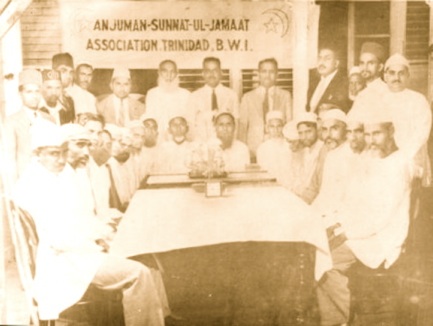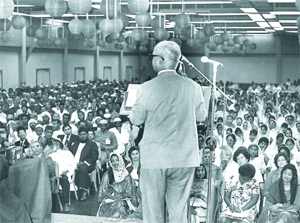The ASJA and its Origins - A Historical Perspective
This body was incorporated by Act No. 24 in the year 1935. The first Secretary of the ASJA was the late Abbas Hosein of San Juan. An early founder- patron of the ASJA was Al-Haj Maulana Shah Mohammed Hassan Al-Qaderi (R.A). 1950 witnessed a Renaissance with the visit of our esteemed Maulana Abdul Aleem Siddiqui and Maulana Fazlur Rahman Ansari (R.A). Maulana Ansari was later to become our Sheikh ul Islam. The ASJA itself, since its incorporation in 1935, has had a most colourful history. From its first President Imam Mohammed Hosein, who was later to serve at the Jama Masjid in San Fernando it can record a meteoric rise to the present day.
In the early years, past Presidents include the late Abdul Ghany and Haji Mohammed Ibrahim. The latter served until he died in 1956. Haji Mohammed Ibrahim assumed the Presidency in 1938 after returning from pilgrimage. The late Abdul Ghany was the President of the ASJA prior to this. During the tenure of Haji Mohammed Ibrahim, the late Mohammed Esau Rahaman served as President for one (1) year in 1949. Sometime in the mid 1950's the late Mohammed Hosein Shah also served as the President of the ASJA. After the death in 1956 of Haji M. Ibrahim, the late Haji John Mohammed assumed the Presidency, with the late Haji Shafik Rahaman as his under study. Succeeding Haji John Mohammed was the late Haji Shafik Rahaman who served as Leader until 1981 when illness forced him to resign.
Throughout the years of the Presidency of both Haji M. Ibrahim and Haji John Mohammed, the late Haji Shafik Rahaman was to play an important role in the ASJA especially in the establishment of the Primary and Secondary schools from 1952. Today, the ASJA manages seven (7) primary schools and six (6) secondary colleges. The first primary schools were established in 1953. The last four (4) ASJA Boys’ and Girls’ Colleges. In the year 2000, Haji Abdul Sattar on the resignation of Haji Shafik due to ill health, took over the Presidency in 1981 until 1990. From that time, Haji Dr. Mansoor Ibrahim has been the serving President. One of the dedicated servants of the ASJA, Dr Wahid Ali, served as President of the Senate for many a year.
The ASJA, today, has been restructured to provide for a Shura Council with a Spiritual Head and Administrative Executive which it is hoped, Insha-Allah, will provide greater momentum in service to the community.
So much for the origins of the three Founding Members. We were at one time all together and in recent times, every effort was made by many by dint of a co-ordinating effort to bring about some degree of unity among the three major Muslim organizations. We always felt we had the ability to formulate change. We must also have the capacity and will to make it a reality. With this ceremony today, the initialling of a Memorandum of Understanding, we have with Allah Subhanahu wa Taala as our Witness, with the goodwill of the leaders and members of our respective Organizations, we’re well on the pathway to success. We, today, lay the formal groundwork for the thrust forward. Nothing must stand in our way. We shall have as our Motto, “Service to Allah with Service to Mankind”. When those whom we serve expect more from us “Are we prepared to give it?” Our effort in all this must be to stabilize the community to produce the best results.
Our aims in the Memorandum include emphasis to engage in service through technology, journalism and the mass media to deliver the message. Our Organizations must co-operate to establish the Islamic Institutions that affect the varied aspects of our lives. We have to contribute to the future generations. (Quote from Dr Ahmed Sakr): “We are not to live with the past but we are to benefit from the past to build a brighter future”. We are to take advantage of the opportunities that present themselves to us. One has to remember the saying of the old persons: “They planted and we ate and we are planting so that they in the future will eat.”
And what did our own Noble Prophet of Islam tell us? “Work for your worldly affairs as if you are to live forever, and work for your Hereafter as if you are to die tomorrow”. If we can say we are proud of our heritage and ancestors, then let us inspire the same feelings in the offsprings of today’s muslims. Let our children be proud of their parents because of their achievements, because of their contributions and for the institutions that their parents were able to establish. Let us all therefore exploit the opportunities we have, to enhance ourselves and our people with the bounties that are available to us. Allah Subhanahu wa Taala has reminded us muslims that only the good hardworking people are the ones who are to govern and to establish themselves on earth.
The establishment of Islamic institutions is a symbol of the presence of a strong and viable community. Islamic institutional development, schools, colleges, hospitals, financial services and the like, an Islamic newspaper, radio and T.V. endeavour to express the cultural aspects of Islam. We can only achieve these when we are united and strong. We shall have now this HOPE and DREAM and, with a clear vision, we cannot fail. It will take all the hard work and sacrifice. Are we prepared for the challenges? Unity will be achieved.
The effort has been a long and pain-staking one. Many of our former leaders staked their reputation on it. We have to enhance each others’ efforts. We will excel only in our desire to serve, and compete only in promoting better facilities. We have the hope, the desire and the will to succeed. We record the past so we can only reshape the future. Our children must stay in school longer to be able to produce a richer people in all the facets of their lives. Our visions must be for a well ordered, organized and disciplined community. We must put systems in place to take care of succession after we have set our our goals and objectives. We have got to identify the young; if not, there will be a serious void in our future plans.
Finally, "Success in life is not what we have but how much we are prepared to give". May Allah Subhanahu wa Taala bless all our efforts.
-- Haji Yacoob Ali.



